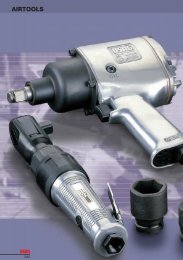Industrial seal self study guide - SKF.com
Industrial seal self study guide - SKF.com
Industrial seal self study guide - SKF.com
Create successful ePaper yourself
Turn your PDF publications into a flip-book with our unique Google optimized e-Paper software.
Chapter 9—Troubleshooting<br />
Preliminary Survey<br />
The best way to troubleshoot is to follow a sequence of steps that<br />
should lead you to the problem.<br />
• What was the <strong>seal</strong> supposed to do? How well has it done the job in<br />
the past? If there is a history of failures, the problem may not be<br />
caused by the <strong>seal</strong> it<strong>self</strong>.<br />
• Was it the right <strong>seal</strong>? Check the <strong>seal</strong>’s part number and look up its<br />
re<strong>com</strong>mended applications. If the correct <strong>seal</strong> has been installed and<br />
there is no history of repeated failures, the problem requires further<br />
investigation.<br />
• Pinpoint the source of the leak. It may be either an I.D. leak or an<br />
O.D. leak. Also, find out when the leak first occurred and see if this<br />
relates to a change in maintenance or operating procedures.<br />
• In the case of exceptional <strong>seal</strong> wear, what is the cause of this wear?<br />
To find out requires failure analysis.<br />
Basic Steps in Analyzing Sealing System Failures<br />
Follow these steps in determining why a <strong>seal</strong> has failed:<br />
• Inspect the <strong>seal</strong> before removal to check the condition of the area,<br />
note the amount of leakage that has occurred, and determine the<br />
source of the leakage (fig. 9a).<br />
Inspect the <strong>seal</strong> and check for signs<br />
of failure (fig. 9a).<br />
• Wipe the area clean and inspect to determine if:<br />
- There are nicks on the bore chamfer,<br />
- The <strong>seal</strong> is cocked in the bore,<br />
- The <strong>seal</strong> was installed improperly,<br />
- There is shaft-to-bore-misalignment,<br />
- The <strong>seal</strong> is loose in the bore,<br />
- The <strong>seal</strong> case is deformed, and/or<br />
- There is paint on the <strong>seal</strong>.<br />
• Rotate the shaft to determine if there is excessive end play<br />
or excessive run-out.<br />
If the leakage cannot be located, follow this procedure:<br />
• Add ultraviolet dye to the sump or spray the area with white powder.<br />
• Operate for 15 minutes.<br />
• Use ultraviolet or regular light to check for leakage.<br />
• Mark the <strong>seal</strong> location at 12 o’clock and remove it carefully.<br />
Check for nicks on the bore chamfer.<br />
78







